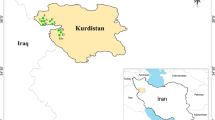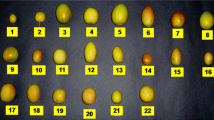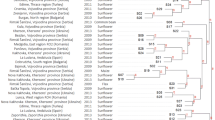Abstract
Fenugreek (Trigonella foenum-graecum) is receiving global attention due to rare medicinal properties of significance to human health. Gene banks possess scanty germplasm and very little background information regarding its genetic variability that has hampered its improvement. We investigated the extent of variability among 17 Indian varieties of fenugreek using phenotypic and genetic markers. Multilocus genotyping by ten random amplified polymorphic DNA (RAPD) primers detected an average of intraspecific variations amounting to 64.7% polymorphism in banding patterns. Analysis of molecular variance indicated that a greater proportion of total genetic variation exists within population (91%) rather than among populations. Higher values of Nei’s gene diversity (h) and Shannon Information Index (i) and genetic distance analysis validate higher genetic diversity among Indian fenugreek varieties. SNPs at 14 sites of rDNA region revealed further lineages of distinct varieties with main RAPD clusters. The representative sequences of each subgroup and all distinct varieties have been submitted to NCBI database and assigned Gen Accession numbers HM 176640–176649. The measures of relative genetic distances among varieties of fenugreek did not completely correlate with the geographical distances of places of their development. The homogeneous phenotypic markers proved insufficient in exhibiting genetic divergence among fenugreek varieties studied. Eventually, the knowledge of their genetic relationships, DNA bar coding and phylogenies might contribute for the designing of intraspecific crosses between cultivars of this fenugreek collection with potential interest in seed spices breeding programme.




Similar content being viewed by others
References
Aggarwal BB, Shishodia S (2006) Molecular targets of dietary agents for prevention and therapy of cancer. Biochem Pharmacol 71(10):1397–1421
Alvarez I, Wendel JF (2003) Ribosomal ITS sequences and plant phylogenetic inference. Mol Phylogenet Evol 29:435–455
Andrew M, Kohn Linda M (2009) Single nucleotide polymorphism-based diagnostic system for crop-associated Sclerotinia species. Appl Environ Microbiol 75:5600–5606
Baker RF, Harberd NP, Jarvist MG, Flavell RB (1988) Structure and evolution of the intragenic region in a ribosomal DNA repeat unit of wheat. J Mol Biol 201:1–17
Baldwin BG, Sanderson MJ, Porter JM, Wojciechowski MF, Campbell CS, Donoghue MJ (1995) The ITS region of nuclear ribosomal DNA: a valuable source of evidence on angiosperm phylogeny. Ann Mol Bot Gard 82:247–277
Balodi B, Rao RR (1991) The genus Trigonella L. (Fabaceae) in the North-west Himalaya. J Econ Tax But 5(1):11–16
Baura G, Szaro TM, Bruns TD (1992) Gastrosuillus laricinus is a recent derivative of Suillus grevillei:molecular evidence. Mycologia 84:592–597
Bradeen JM, Bach IC, Briard M, Le Clerc V, Grzebelus D, Senalik DA, Simon PW (2002) Molecular diversity analysis of cultivated carrot (Daucus carota L.) and wild Daucus populations reveals a genetically nonstructured composition. J Am Soc Hortic Sci 127:383–391
Bruns TD, White TJ, Taylor JW (1991) Fungal molecular systematics. Annu Rev Ecol Syst 22:525–564
Carvalho A, Guedes-Pinto H, Lima Brito J (2009) Genetic diversity among old Portugese bread wheat cultivars and botanical varieties evaluated by ITS rDNA PCR-RFLP markers. J Genet 88(3):363–367
Casiva PV, Saidman BO, Vilardin JC, Cialdella AM (2002) First comparative phonetic studies of Argentinean species of Acacia (Fabaceae) using morphometric isozymal and RAPD approaches. Am J Bot 89:843–853
Cottrell JE, Forrest GI, White MS (1997) The use of random amplified DNA markers to identify and estimate the relatedness of clones belonging to the genus Populus. Bot J Scotland 49:89–102
Cullings KW (1994) Molecular phylogeny of the monotropoideae (Ericaceae) with a note on the placement of the Pyroloideae. J Evol Biol 7:501–516
Cullings KW, Szaro TM, Bruns TD (1996) Evolution of extreme specialization within a lineage of ectomycorrhizal epiparasites. Nature 379:63–66
Dangi RS, Lagu MD, Choudhary LB, Ranjekar PK, Gupta VS (2004) Assessment of genetic diversity in Trigonella foenum-graecum and Trigonella caerulea using ISSR and RAPD markers. BMC Plant Biol 4(13):1–11
De Bustos A, Jouve N (2002) Phylogenetic relationships of the genus Secale based on the characterization of Rdna its sequences. Plant Syst Evol 235:147–154
Ellison W, Liston A, Steiner J, Williams W, Taylor N (2006) Molecular phylogenetics of the clover genus (Trifolium-Leguminoseae). Mol Phylogenet Evol 39:688–705
Esselman EJ, Jianqiamg L, Crawford DJ, Windus JL, Welfe AD (1999) Clonal diversity in the rare Calamagrostis porteri spp. insperata (Poaceae): comparative results for allozymes and random amplified polymorphic DNA and inter-simple sequence repeat markers. Mol Ecol 8:443–453
Esselman EJ, Crawford D, Brauner S, Stussy IF, Anderson GJ, Silva MO (2000) RAPD marker diversity within and divergence among species of Dendroseris (Asteraceae: Lactuaceae). Am J Bot 87:591–596
Hershkovitz MA, Lewis LA (1996) Deep level diagnostic value of the rDNA-ITS region. Mol Biol Evol 13:1276–1295
Hershkovitz MA, Zimmer EA, Hahn WJ (1999) Ribosoml DNA sequences and angiosperm systematics. In: Hollingsworth PM, Bateman RM, Gornall RJ (eds) Molecular systematics and plant evolution. Taylor and Francis, London, pp 268–326
Hsiao C, Chatterton NJ, Asay KH, Jensen KB (1994) Phlogenetic relationships of 10 grass species: an assessment of phylogenetic utility of the internal transcribed spacer region in nuclear ribosomal DNA in monocots. Genome 37:112–120
Hymowitz T (1990) Grain Legumes. In: Janick J, Simon JE (eds) Advances in new crop. Timber Press, Portland, OR, pp 54–57
Jorgenson RD, Cluster PD (1988) Modes and tempos in the evolution of nuclear ribosomal DNA: new characters of evolutionary studies and new markers for genetic and population studies. Ann Missouri Bot Garden 75:1238–1247
Kermani M, Marashi H, Nasiri M, Nezhad S, Shahriari F (2006) Evaluation of genetic diversity in Iranian Cumin (Cuminum cyminum) using AFLP markers. The first Agricultural Biotechnology Congress, Kermanshsh, Iran
Lewontin RC (1972) The apportionment of human diversity. Evolutionary Biol 6:391–398
Maidak BL, Olsen GJ, Larsen N, Overbeek R, Mc Caughey M, Woese CR (1997) The RDP (Ribosomal Database Project). Nucleic Acids Res 25:109–110
Majeed S (2005) Assessment of genetic divergence and in vitro conservation in Bunium persicum (Boiss.) Fedtsch. Ph.D. Thesis, University of Horticulture and Forestery. Himachal Pradesh, India
Malhotra SK, Vashishtha BB (2008) Organic production of seed spices. National Research Centre for Seed Spices, Ajmer, India, p 90
Martins SR, Vences FJ, Saenz de Miera LE, Barrosa MR, Carnide V (2006) RAPD analysis of genetic diversity among and within Portuguese landraces of common white bean (Phaseolus vulgaris L.). Sci Hort 108:133–142
Muminovic J, Melchinger AE, Lubberstedt T (2004) Prospects of Celeriac (Apium graveolens var. rapaceum) improvement by using genetic resources of Apium as determined by AFLP markers and morphological characterization. Plant Genetic Resources 2:189–198
Nalini E, Bhagwat SG, Jawali N (2007) Identification and characterization of some ITS variants from hexaploid wheat (Triticum aestivum L.). Plant Sci 173:262–268
Nei M (1973) Analysis of gene diversity in subdivided populations. Proc Natl Acad Sci USA 70:3321–3323
Olli S, Kirti PB (2006) Cloning, characterization and antifungal activity of defensin Tfgd I from Trigonella foenum-graecum L. J Biochem Mol Biol 39(3):278–283
Olli S, Guruprasad L, Kirti PB (2007) Characterization of defensin (TFGD 2) from Trigonella foenum-graecum. Current Sci 93(3):365–369
Page RDM (1996) Tree View: an application to display phylogenetic on personal computers. Comput Appl Biol Sci 12:357–358
Peakall R, Smouse PE (2006) GENALEX 6: genetic analysis in Excel. Population software for teaching and research Mol Ecol Notes 6:288–295
Pezhmanmehr M, Hassani MS, Jahansooz F, Najafi AA, Sefidkon F, Mardi M, Pirseidi M (2009) Assessment of genetic diversity in some Iranian populations of Bunium persicum using RAPD and AFLP markers. Iranian J Biotechnol 7(2):93–100
Polhil RM, Raven PH (1981) Advances in legume systematic. Royal Botanical Gardens, Kew, England, 2
Powell W, Orozco-Castillo C, Chalmers KJ, Provan J, Waugh R (1995) Polymerase chain reaction-based assays for the characterization of plant genetic resources. Electrophoresis 16:1726–30
Preet A, Siddiqui MR, Taha A, Badhai J, Hussain ME, Yadava PK, Baquer NZ (2006) Long-term effect of Trigonella foenum-graecum and its combination with sodium orthovanadate in preventing histopathological and biochemical abnormalities in diabetic rat ocular tissues. J Mol Cellular Biochem 289(1/2):137–147
Rohlf FJ (1997) NTSYS pc: numerical taxonomy and multivariate analysis system Version 2.02h. Exeter software, New York
Saini A, Reddy SK, Jawali N (2008) Intra individual and intra species heterogeneity in nuclear rDNA ITS region of Vigna species from subgenus Ceratotropis. Genet Res 90:299–316
Sambrook J, Fritsch EF, Maniatis T (1989) A laboratory manual, 2nd edn. Cold Spring Harbor laboratory press, Plainview, New York
Sharma RD (1990) Effect of Fenugreek on blood glucose and serum lipids in type I diabetes. European J Clinical Nutrition 44:301–306
Sharma S, Rustgi S, Balyan HS, Gupta PK (2002) Internal Transcribed Spacer (ITS) sequences of ribosomal DNA of barley and their comparison with ITS sequences in common wheat. Barley Genet Newslett 32:38–45
Shishodia S, Aggarwal BB (2006) Diosgenin inhibits osteoclastogenesis, invasion and proliferation through the downregulation of Akt, I Kappa B kinase activation and NF-Kappa B-regulated gene expression. Oncogene 25(10):1463–1473
Sneath PHA, Sokal RR (1973) Numerical taxonomy. W.H. Freeman, San Francisco, California
Solouki M, Mehdikhani H, Zeinali H, Emamjomeh AA (2008) Study of genetic diversity in Chamomile (Matricaria chamomilla) based on morphological traits and molecular markers. Sci Hort 117:281–287
Vogler DR, Bruns TD (1998) Phylogenetic relationships among the Pine stem rust fungi (Cronartium and Peridermium spp.). Mycologia 90:244–257
White TJ, Bruns SL, Taylor J (1990) In PCR protocols: a guide to methods and applications. MA Innis, DH Geltand, TT Sninsky, TJ White, eds. Academic Press, San Diego, California, p 315
Williams JGK, Kubelik AR, Livak KJ, Rafalski JA, Tingey SV (1990) DNA polymorphism amplified by arbitrary primers are useful as genetic markers. Nucleic Acids Res 18:6531–6535
Acknowledgements
The authors are thankful to Dr. M.M. Anwar, Director, National Research Centre for Seed Spices, Tabiji, Ajmer and Dr. M.M. Roy, Director Central Arid Zone Research Institute, Jodhpur for financial support and facilitating collaborative research work on “Molecular Characterization of Indian Seed Spices”.
Author information
Authors and Affiliations
Corresponding author
Rights and permissions
About this article
Cite this article
Kakani, R.K., Singh, S.K., Pancholy, A. et al. Assessment of Genetic Diversity in Trigonella foenum-graecum Based on Nuclear Ribosomal DNA, Internal Transcribed Spacer and RAPD Analysis. Plant Mol Biol Rep 29, 315–323 (2011). https://doi.org/10.1007/s11105-010-0233-x
Published:
Issue Date:
DOI: https://doi.org/10.1007/s11105-010-0233-x




